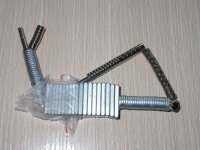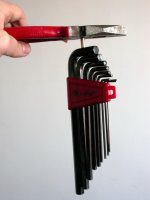I've put an axial B field on a cylindrical HV diode and the Rp goes up with the field. (posted some curve tracer curves somewhere here a while back) The longer curved electron path length to the plate apparently is equivalent to a greater geometric distance between cathode and plate.
AC demagnetizing of beam deflection tubes is well worthwhile. Greatly improves the linearity and balance.
Not much effect on ordinary triodes though, maybe increases the plate Rp a little if oriented axially. So AC demagnetizing might lower plate Rp a smidgeon.
AC demagnetizing of beam deflection tubes is well worthwhile. Greatly improves the linearity and balance.
Not much effect on ordinary triodes though, maybe increases the plate Rp a little if oriented axially. So AC demagnetizing might lower plate Rp a smidgeon.
The AC magnetic field from a heater will cause some electron deflection, but not much and it will probably be at twice line frequency. 'DC' magnetisation will act as a bias and increase the effect. Only a small effect, but we don't want any hum at all.
At what temperature does nickel lose its magnetisation?
At what temperature does nickel lose its magnetisation?
Those magnetron curves are wild, it looks almost like one could vary a current through a field coil to get the equivalent of a variable shunt regulator. The curves look much like a Zener diode. I guess microwave ovens must have very strong magnets to need much higher voltages for the tubes. (why they oscillate is another story too). Oh, ham radio types discovered long ago that power transformers from dead microwave ovens made great cheap plate transformers. Too much voltage for most things audio, but maybe those 811A based SET amps?
Very unlikely that an external magnetic field would be strong enough to deflect a grid, unless the valve was very badly made with useless grid supports.
Yes, the magnetic effect would be secondary, the tubes in question (decent quality current production) had already been rattled in the amp to the point of being microphonic, so the grids were probably saggy by that point.
Here were some curve tracer curves for a cylindrical 6S4A triode with axial magnetic field:
http://www.diyaudio.com/forums/tubes-valves/160240-suppresor-grid-used-feedback-10.html#post2098849
and check the post above that one for an axial rectifier in an axial B field.
http://www.diyaudio.com/forums/tubes-valves/160240-suppresor-grid-used-feedback-10.html#post2098849
and check the post above that one for an axial rectifier in an axial B field.
Last edited:
Any looking for some really powerful magnets to experiment with might try those used in many old hard drives by the coil that moves the head assembly. They are so strong that one must be careful not to get skin between them and a ferrous surface or injury may result. I suppose that a magnet could change the beam in a 6BK4B or similar shunt regulator and make it hit the side of the tubular anode instead of the plate across the inside of the top changing where the tube glows and throws off energy, but it is not safe to be near one of those while operating to see. (They were known hazards in 60's tv sets, most fully described in the data sheets for similar tubes issued around 1970 or so when awareness of the problem was higher) Any such tubes are unsuitable for operation at maximum voltages without heavy shielding as being near them may be as unhealthy as watching a misadjusted 60's tv at close range. Some use them to drive electrostatics.
Today we receive a lot of thulium magnetic for a researching project (they are super strong magnetic!). The EL-34 PP amp came into my eyes when we were discussing about the project. A strange idea came into my brain suddenly: the magentic can affect the moving path of electron, and the tube is working based on electron emitting and moving, so how will the magnetic affect the tube amplifiers?
A long time ago in a galaxy far far away, a company called GenRad used this principle in their tube based noise generator. RIP GenRad.
One of the most strong magnetic is NbFeB, which I used to did the test. It's also used in Alpha Magnetic Spectrometer on international space station.
There's a very big NbFeB magnet on it, one of my classmate invoved in this project.
You may have some idea on how strong NbFeB is by the following photo. The wrenchs weight about 0.55kg, the diameter of the magnet is only 4mm!
The super strong magnet really hurts sometimes. A friend told me, one day in 2002 summer,
there'were 2 match box size NbFeB block on the edge of a desk in their lab. A guy come across, maybe one of the magnet was touched by him, suddenly the
2 magnets attracted each other..worst of all, something in the middle of his legs was caught between the magnets.. They have to send the poor man to the hospital. He was very badly hurted!
There's a very big NbFeB magnet on it, one of my classmate invoved in this project.
You may have some idea on how strong NbFeB is by the following photo. The wrenchs weight about 0.55kg, the diameter of the magnet is only 4mm!
The super strong magnet really hurts sometimes. A friend told me, one day in 2002 summer,
there'were 2 match box size NbFeB block on the edge of a desk in their lab. A guy come across, maybe one of the magnet was touched by him, suddenly the
2 magnets attracted each other..worst of all, something in the middle of his legs was caught between the magnets.. They have to send the poor man to the hospital. He was very badly hurted!
Any looking for some really powerful magnets to experiment with might try those used in many old hard drives by the coil that moves the head assembly.
Attachments
Here were some curve tracer curves for a cylindrical 6S4A triode with axial magnetic field:
http://www.diyaudio.com/forums/tubes-valves/160240-suppresor-grid-used-feedback-10.html#post2098849
and check the post above that one for an axial rectifier in an axial B field.
Wow, I missed that first time around. "Stack of toroidal magnets slipped over the tube!" I congratulate you for going MUCH more extreme than I did.
If any are considering recycling toroidal magnets from old magnetrons, use caution not to break the tube. As with some transmitting tubes occasionally tried for audio, there may be beryllium oxide in the ceramic to improve heat flow. Inhaling dust from that may cause internal bleeding.
A static magnetic field will bend a beam of electrons - that is how a TV CRT works. It won't make much difference to a triode, because all the electrons end up at the anode eventually.
I can just see the next 'audiofool' trend! Take a 5 dollar magnet, put it in a 2 dollar ceramic case, and charge people 95 dollars for a "static field audio enhancer".
why not? suckers are all around waiting to buy snake oils for their bragging rights......
To follow on from Merlin's post #18, the three 1948 correspondences that discuss the EF37 hum issue are collated in the link below.
https://www.dalmura.com.au/static/Demag%20EE%201948.pdf
Of interest is that Williamson raised this EF37 hum topic in his "New Version" Oct 1949 WW article - Williamson had left the Marconi-Osram applications lab nearly 4 years earlier, and L.H.Light was from the Mullard Valve Application Laboratory, and Williamson would have been preparing his EF37 preamp design for WW publication in the Ferranti lab during 1948.
https://www.dalmura.com.au/static/Demag%20EE%201948.pdf
Of interest is that Williamson raised this EF37 hum topic in his "New Version" Oct 1949 WW article - Williamson had left the Marconi-Osram applications lab nearly 4 years earlier, and L.H.Light was from the Mullard Valve Application Laboratory, and Williamson would have been preparing his EF37 preamp design for WW publication in the Ferranti lab during 1948.
Moving a magnet near the tube will induce a small voltage (Faraday's Law). A static magnet, unless it's ridiculously powerful, will have close to zero effect on the tube's operation.
Bunk!! Ordinary magnets have a strong effect on old TV tubes which operate at 21kV, electron beams running at a few hundred volts are 100 times more sensitive to magnetic field.
Ever heard of a magnetron? Ever waved a magnet near a "magic eye" tube?
Basically a magnet will disrupt a tube, and most likely not in a good way - for instance it might be a good way to fry the screen in a beam tetrode.
What are the grid wires made of? If they're magnetic a strong magnet could move them, possibly causing them to touch the cathode. That would cause an audible "pop".
Grid wires are usually tungsten or molybdenum.
- Status
- This old topic is closed. If you want to reopen this topic, contact a moderator using the "Report Post" button.
- Home
- Amplifiers
- Tubes / Valves
- How the magnetic affect the sound of tube amplifier

